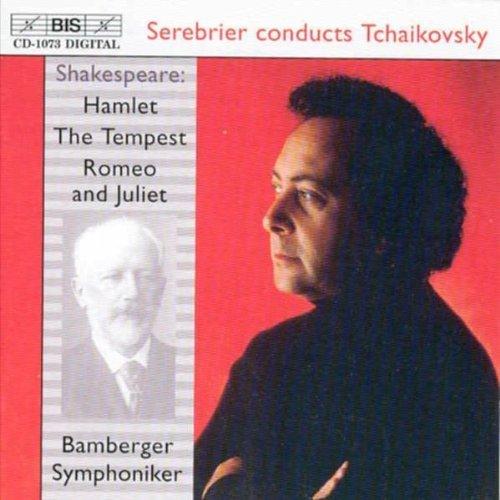Serebrier conducts Tchaikovsky
A unique and apt Tchaikovsky coupling brilliantly performed and recorded
View record and artist detailsRecord and Artist Details
Composer or Director: Pyotr Ilyich Tchaikovsky
Genre:
Orchestral
Label: BIS
Magazine Review Date: 9/2002
Media Format: CD or Download
Media Runtime: 62
Mastering:
Stereo
DDD
Catalogue Number: BISCD1073

Tracks:
| Composition | Artist Credit |
|---|---|
| Hamlet |
Pyotr Ilyich Tchaikovsky, Composer
Bamberg Symphony Orchestra José Serebrier, Conductor Pyotr Ilyich Tchaikovsky, Composer |
| (The) Tempest |
Pyotr Ilyich Tchaikovsky, Composer
Bamberg Symphony Orchestra José Serebrier, Conductor Pyotr Ilyich Tchaikovsky, Composer |
| Romeo and Juliet |
Pyotr Ilyich Tchaikovsky, Composer
Bamberg Symphony Orchestra José Serebrier, Conductor Pyotr Ilyich Tchaikovsky, Composer |
Author:
What a good idea to couple Tchaikovsky’s three fantasy overtures inspired by Shakespeare. José Serebrier follows up the first impressive disc in his Tchaikovsky series for BIS (Francesca da Rimini and the Fourth Symphony‚ 3/02) with this fine Shakespeare disc. He writes an illuminating note on the genesis of each of the three‚ together with an analysis of their structure. He notes that once Tchaikovsky had established his concept of the fantasy overture in the first version of Romeo and Juliet in 1869 – slow introduction leading to alternating fast and slow sections‚ with slow coda – he used it again both in the 1812 Overture and Hamlet. The Tempest (1873)‚ based on a programme suggested by the art historian‚ Vladimir Stasov‚ has similarly contrasting sections‚ but begins and ends with a gently evocative seascape‚ with shimmering arpeggios from strings divided in 13 parts.
It is typical of Serebrier’s performance that he makes that effect sound so fresh and original‚ and I wonder for the first time whether it gave Sibelius the idea for the opening of En Saga. In many ways‚ early as it is‚ this is stylistically the most radical of the three overtures here‚ with sharp echoes of Berlioz in some of the woodwind effects. The clarity of Serebrier’s performance‚ both in texture and in structure‚ helps to bring that out‚ as does a warm and analytical BIS recording.
Hamlet‚ dating from much later‚ is treated to a similarly fresh and dramatic reading‚ with Serebrier bringing out the yearningly Russian flavour of the lovely oboe theme representing Ophelia. He may not quite match the thrusting power of his mentor‚ Stokowski‚ but he is not far short‚ and brings out far more detail‚ bearing out that maestro’s remark about his pupil being ‘a master of orchestral balance’.
Serebrier is also meticulous in seeking to observe the dynamic markings in each score. Those in The Tempest are nothing if not extravagant – up to a fortissimo of five fs in the final statement of the love theme – yet Serebrier graduates the extremes with great care. In Romeo and Juliet‚ like Abbado but unlike Dorati‚ he is just as careful over observing Tchaikovsky’s relatively modest markings‚ so that the central development section‚ built on the conflict music‚ is rightly restrained in observance of the markings‚ mainly mezzoforte but down to pp for the violins in places. This is the opposite of a ‘whamithome’ approach like Dorati’s‚ with fortissimos coming far too easily: yet the wonderfully drilled and committed playing of the Bamberg Orchestra‚ incisive as in the earlier BIS disc‚ with outstanding solos from wind and brass‚ ensures that there is no lack of power. It is good to welcome so refreshing a Tchaikovsky disc.
Discover the world's largest classical music catalogue with Presto Music.

Gramophone Digital Club
- Digital Edition
- Digital Archive
- Reviews Database
- Full website access
From £8.75 / month
Subscribe
Gramophone Full Club
- Print Edition
- Digital Edition
- Digital Archive
- Reviews Database
- Full website access
From £11.00 / month
Subscribe
If you are a library, university or other organisation that would be interested in an institutional subscription to Gramophone please click here for further information.




